Trees are rare in the savanna biome because of
- A) insufficient annual precipitation.
- B) acidic soils.
- C) frequent fires.
- D) large variations in seasonal rainfall.
- E) permafrost.
C
Which of the following statements best describes the effect of climate on biome distribution?
- A) Average annual temperature and precipitation are sufficient to predict which biome will be found in an area.
- B) Seasonal fluctuation of temperature is not a limiting factor in biome distribution if areas have the same annual temperature and precipitation means.
- C) Not only is the average climate important in determining biome distribution but so is the pattern of climatic variation.
- D) Temperate forests and grasslands are different biomes because they receive a different quality and quantity of sunlight, even though they have essentially the same annual temperature and precipitation.
- E) Correlation of climate with biome distribution is sufficient to determine the cause of biome patterns.
C
The growing season would generally be shortest in which of the following biomes?
- A) savanna
- B) temperate broadleaf forest
- C) temperate grassland
- D) tropical rain forest
- E) northern coniferous forest
E
Trees are not usually found in the tundra biome because of
- A) insufficient annual precipitation.
- B) acidic soils.
- C) extreme winter temperatures.
- D) overbrowsing by musk ox and caribou.
- E) permafrost.
E
Which of the following levels of ecological organization is arranged in the correct sequence from most to least inclusive?
- A) community, ecosystem, individual, population
- B) ecosystem, community, population, individual
- C) population, ecosystem, individual, community
- D) individual, population, community, ecosystem
- E) individual, community, population, ecosystem
B
Which of the following choices causes all of the others in creating global terrestrial climates?
- A) differential heating of Earth's surface
- B) ocean currents
- C) global wind patterns
- D) evaporation of water from ocean surfaces
A
Why is the climate drier on the leeward side of mountain ranges that are subjected to prevailing winds?
- A) Deserts create dry conditions on the leeward side of mountain ranges.
- B) The sun illuminates the leeward side of mountain ranges at a more direct angle, creating heat energy that evaporates most of the water present.
- C) Pushed by the prevailing winds on the windward side, air is forced to rise, cool, condense, and drop its precipitation, leaving drier air to descend the leeward side.
- D) Air masses pushed by the prevailing winds are stopped by mountain ranges, and the moisture is used up in the stagnant air masses on the leeward side.
- E) When compared to the windward side, more organisms live on the sheltered, leeward side of mountain ranges where their utilization of water lowers the amount available.
C
What would be the effect on climate in the temperate latitudes if Earth were to slow its rate of rotation from a 24-hour period of rotation to a 48-hour period of rotation?
- A) Seasons would be longer and more distinct (colder winters and warmer summers).
- B) Smaller ranges between daytime high and nighttime low temperatures would be frequent.
- C) Large-scale weather events such as tornadoes and hurricanes would no longer be a part of regional climates.
- D) Winter seasons in both the Northern and Southern Hemispheres would have more abundant and frequent precipitation events.
- E) Larger ranges between daytime high and nighttime low temperatures would be frequent.
E
Palm trees and subtropical plants are commonplace in Land's End, England, whose latitude is the equivalent of Labrador in coastal Canada, where the local flora is subarctic. Which statement best explains why this apparent anomaly exists between North America and Europe?
- A) Labrador does not get enough rainfall to support the subtropical flora found in Land's End.
- B) Regions such as Labrador are actually colder than England because colder Arctic water flows down to eastern North America and warm water from the equator flows to England.
- C) Rainfall fluctuates greatly in England; rainfall is consistently high in Labrador.
- D) Labrador is too windy to support tall plants, such as palm trees.
- E) Labrador receives sunlight of lower duration and intensity than does Land's End.
B
In mountainous areas of western North America, north-facing slopes would be expected to
- A) receive more sunlight than similar southern-exposed slopes.
- B) be warmer and drier than comparable southern-exposed slopes.
- C) consistently be steeper than southern-exposed slopes.
- D) support biological communities similar to those found at lower elevations on similar south-facing slopes.
- E) support biological communities similar to those found at higher elevations on similar south-facing slopes.
E
Deserts typically occur in a band around 30 degrees north and 30 degrees south latitude because
- A) descending air masses originating from the tropics tend to be dry.
- B) trade winds have little moisture.
- C) moisture-laden air is heavier than dry air and is not carried to these latitudes.
- D) these locations get the most intense solar radiation of any location on Earth.
A
Which of the following events might you predict to occur if the tilt of Earth's axis relative to its plane of orbit was increased to 33 1/2 degrees?
- A) Summers and winters in the United States would likely become warmer and colder, respectively.
- B) Winters and summers in Australia would likely become less distinct seasons.
- C) Seasonal variation at the equator might decrease.
- D) Both Northern and Southern Hemispheres would experience summer and winter at the same time.
- E) Both poles would experience massive ice melts.
A
Imagine that some cosmic catastrophe jolts Earth so that its axis is perpendicular to the orbital plane between Earth and the sun. The most obvious effect of this change would be
- A) the elimination of tides.
- B) an increase in the length of night.
- C) an increase in the length of a year.
- D) a decrease in temperature at the equator.
- E) the elimination of seasonal variation.
E
The main reason that polar regions are cooler than the equator is that
- A) there is more ice at polar regions.
- B) sunlight strikes polar regions at a lower angle.
- C) the polar regions are farther from the sun.
- D) the polar regions' atmosphere is thinner and contains fewer greenhouse gases.
- E) the polar regions are permanently tilted away from the sun.
B
Generalized global air circulation and precipitation patterns are caused by
- A) rising, warm, moist air masses that cool and release precipitation as they rise and then, at high altitude, cool and sink back to the surface as dry air masses after moving north or south of the tropics.
- B) air masses that are dried and heated over continental areas that rise, cool aloft, and descend over oceanic areas followed by a return flow of moist air from ocean to land, delivering high amounts of precipitation to coastal areas.
- C) polar, cool, moist high-pressure air masses from the poles that move along the surface, releasing precipitation along the way to the equator, where they are heated and dried.
- D) the revolution of Earth around the sun.
- E) mountain ranges that deflect air masses containing variable amounts of moisture.
A
Air masses formed over the Pacific Ocean are moved by prevailing westerlies where they encounter extensive north-south mountain ranges, such as the Sierra Nevadas and the Cascades. Which statement best describes the outcome of this encounter between a landform and an air mass?
- A) The cool, moist Pacific air heats up as it rises, releasing its precipitation as it passes the tops of the mountains, and this warm, now dry air cools as it descends on the leeward side of the range.
- B) The warm, moist Pacific air rises and cools, releasing precipitation as it moves up the windward side of the range, and this cool, now dry air mass heats up as it descends on the leeward side of the range.
- C) The cool, dry Pacific air heats up and picks up moisture from evaporation of the snowcapped peaks of the mountain range, releasing this moisture as precipitation when the air cools while descending on the leeward side of the range.
- D) These air masses are blocked by the mountain ranges, producing high annual amounts of precipitation on the windward sides of these mountain ranges.
- E) These air masses remain essentially unchanged in moisture content and temperature as they pass over these mountain ranges.
B
Coral reefs can be found on the southeast coast of the United States but not at similar latitudes on the southwest coast. Differences in which of the following most likely account for this?
- A) sunlight intensity
- B) precipitation
- C) day length
- D) ocean currents
- E) salinity
D
What is the limiting factor for the growth of trees in the tundra?
- A) low precipitation
- B) lack of sunlight
- C) insufficient minerals in bedrock
- D) pH of soils
- E) permafrost
E
In which of the following terrestrial biome pairs are both biomes dependent upon periodic burning?
- A) tundra and coniferous forest
- B) chaparral and savanna
- C) desert and savanna
- D) tropical forest and temperate broadleaf forest
- E) grassland and tundra
B
Fire suppression by humans
- A) will always result in an increase in species diversity in a given biome.
- B) can change the species composition within biological communities.
- C) will result in fewer trees in savannas.
- D) is necessary to maintain species composition in grassland and chaparral.
B
Which of the following statements best describes the interaction between fire and ecosystems?
- A) Fires maintain the low, widely scattered vegetation found in deserts.
- B) Many kinds of plants and plant communities have adapted to frequent fires.
- C) Unlike northern coniferous forests, temperate broadleaf forests contain many species that depend on fire to regenerate.
- D) Chaparral communities have evolved to the extent that they rarely burn.
- E) Fire is unnatural in ecosystems and should be prevented.
B
Which marine zone is expected to have the lowest rates of primary productivity (photosynthesis)?
- A) pelagic
- B) abyssal
- C) photic
- D) limnetic
- E) intertidal
B
If a meteor impact or volcanic eruption injected a lot of dust into the atmosphere and reduced the sunlight reaching Earth's surface by 70% for one year, which of the following marine communities most likely would be least affected?
- A) deep-sea vent
- B) coral reef
- C) intertidal
- D) pelagic
- E) estuary
A
Which statement best describes how climate might change if Earth were 75% land and 25% water?
- A) Terrestrial ecosystems would likely experience more precipitation.
- B) Earth's daytime temperatures would be higher and nighttime temperatures lower.
- C) Summers would be longer and winters shorter at midlatitude locations.
- D) Earth would experience an unprecedented global warming.
- E) More terrestrial microclimates would be created because of daily fluctuations in climate.
B
Which of the following examples of an ecological effect leading to an evolutionary effect is most correct?
- A) When seeds are not plentiful, trees produce more seeds.
- B) A few organisms of a larger population survive a drought, and then these survivors emigrate to less arid environments.
- C) A few individuals with denser fur survive the coldest days of an ice age, and the reproducing survivors of the ice age all have dense fur.
- D) Fish that swim the fastest in running water catch the most prey and more easily escape predation.
- E) The insects that spend the most time exposed to sunlight have the most mutations.
C
Which of the following are important biotic factors that can affect the structure and organization of biological communities?
- A) precipitation, wind
- B) nutrient availability, soil pH
- C) predation, competition
- D) temperature, water
- E) light intensity, seasonality
C
A certain species of pine tree survives only in scattered locations at elevations above 2,800 m in the western United States. To understand why this tree grows only in these specific places, an ecologist should
- A) conclude that lower elevations are limiting to the survival of this species.
- B) study the anatomy and physiology of this species.
- C) investigate the various biotic and abiotic factors that are unique to high altitude.
- D) analyze the soils found in the vicinity of these trees, looking for unique chemicals that may support their growth.
- E) collect data on temperature, wind, and precipitation at several of these locations for a year.
C
Studying species transplants is a way that ecologists
- A) determine the abundance of a species in a specified area.
- B) determine the distribution of a species in a specified area.
- C) develop mathematical models for distribution and abundance of organisms.
- D) determine if dispersal is a key factor in limiting distribution of organisms.
- E) consolidate a landscape region into a single ecosystem.
D
Which of the following is a physical factor that can limit the geographic distribution of species?
- A) predation
- B) disease
- C) soil structure
- D) nutrients
- E) pH
C
A population is correctly defined as having which of the following characteristics?
- inhabits the same general area
- belongs to the same species
III. possesses a constant and uniform density and dispersion
- A) I only
- B) III only
- C) I and II only
- D) II and III only
- E) I, II, and III
C
An ecologist recorded 12 white-tailed deer, Odocoileus virginianus, per square mile in one woodlot and 20 per square mile in another woodlot. What was the ecologist comparing?
- A) density
- B) dispersion
- C) carrying capacity
- D) cohorts
- E) range
A
Uniform spacing patterns in plants such as the creosote bush are most often associated with
- A) chance.
- B) patterns of high humidity.
- C) the random distribution of seeds.
- D) competitive interaction between individuals of the same population.
- E) the concentration of nutrients within the population's range.
D
Which of the following groups would be most likely to exhibit uniform dispersion?
- A) red squirrels, animals that actively defend territories
- B) cattails, plants that grow primarily at edges of lakes and streams
- C) dwarf mistletoes, plants that parasitize particular species of forest trees
- D) moths in a city at night
- E) lake trout, fish that seek out cold, deep water high in dissolved oxygen
A
To construct a life table for a sexual species, one needs to
- A) assess sperm viability for the males in the population.
- B) keep track of all of the offspring of a cohort.
- C) keep track of the females in a cohort.
- D) keep track of all of the offspring of the females in a cohort.
C
Which of the following methods would most accurately measure the density of the population being studied?
- A) counting the number of prairie dog burrows per hectare
- B) counting the number of times a 1-km transect is intersected by tracks of red squirrels after a snowfall
- C) counting the number of coyote droppings per hectare
- D) counting the number of moss plants in 1-m2quadrats
- E) counting the number of zebras from airplane observations.
D
Long-term studies of Belding's ground squirrels show that immigrants move nearly 2 km from where they are born and become 1-8% of the males and 0.7-6% of the females in other populations. On an evolutionary scale, why is this significant?
- A) These immigrants make up for the deaths of individuals, keeping the other populations' sizes stable.
- B) Young reproductive males tend to stay in their home population and are not driven out by other territorial males.
- C) These immigrants provide a source of genetic diversity for the other populations.
- D) Those individuals that emigrate to these new populations are looking for less crowded conditions with more resources.
E) Gradually, the populations of ground squirrels will move from a clumped to a uniform population pattern of dispersion
C
Which of the following sets of measurements would best describe a population's physical structure and vital statistics?
- A) density, dispersion, and demographics
- B) gene frequency over time and the ratio of reproductive to nonreproductive individuals
- C) annual precipitation averages and mean annual temperatures
- D) minimum and maximum amounts of precipitation and annual temperature extremes
- E) ratio of predators and the number of immigrants and emigrants
A
Which of the following methods would provide the most legitimate data on population density?
- A) Count the number of nests of a particular species of songbird and multiply this by two (because there are two parent birds per nest).
- B) Count the number of pine trees in several randomly selected 10-m × 10-m plots and extrapolate this number to the fraction of the study area that these plots represent.
- C) Use the mark-and-recapture method to estimate the size of the population.
- D) Calculate the difference between all of the immigrants and emigrants to see if the population is growing or shrinking.
- E) Add the number of births and subtract the number of individuals that die to see if the population's density is increasing or decreasing.
B
Which of the following is the best natural example of uniform distribution?
- A) bees collecting pollen in a wildflower meadow
- B) snails in an intertidal zone at low tide
- C) territorial songbirds in a mature forest during mating season
- D) mushrooms growing on the floor of an old-growth forest
- E) a cultivated cornfield in the Midwest
C
Which of the following would most likely promote random distribution?
- A) territorial species
- B) species that secrete chemicals to attract or inhibit other individuals
- C) flocking and schooling behaviors
- D) spacing during the breeding season
- E) homogeneous chemical and physical factors in the environment
E
Which of the following best defines a cohort?
- A) a group of individuals that inhabits a small isolated region within the range for the species
- B) all of the individuals that are annually added to a population by birth and immigration
- C) the reproductive males and females within the population
- D) a group of individuals from the same age group, from birth until they are all dead
- E) the number of individuals that annually die or emigrate out of a population
D
Why do some invertebrates, such as lobsters, show a "stair-step" survivorship curve?
- A) Many invertebrates mate and produce offspring on multiyear cycles.
- B) Within a species of invertebrates, younger individuals have a higher survivorship than older individuals.
- C) Many invertebrates molt in order to grow, and they are vulnerable to predation during their "soft shell" stage.
- D) Many invertebrate species have population cycles that go up and down according to the frequency of sunspots.
- E) The number of fertilized eggs that mature to become females in many species of invertebrates is based on ambient temperature.
C
What is population dispersion?
- A) the number of individuals per unit area or volume
- B) the pattern of spacing among individuals within the boundaries of the population
- C) the influx of new individuals from other areas
- D) the defense of a bounded physical space against encroachment by others
B
Which of the following describes a Type II survivorship curve?
- A) flat at the start, reflecting low death rates during early and middle life, then dropping steeply as death rates increase among older age groups
- B) dropping sharply at the start, reflecting very high death rates for the young, then flattening out as death rates decline for those few that survive
- C) a constant death rate over the organism's life span
- D) flat at the start, reflecting low death rates during early and middle life, then rising steeply as death rates decrease among older age groups
C
A population of ground squirrels has an annual per capita birth rate of 0.06 and an annual per capita death rate of 0.02. Calculate an estimate of the number of individuals added to (or lost from) a population of 1,000 individuals in one year.
- A) 120 individuals added
- B) 40 individuals added
- C) 20 individuals added
- D) 400 individuals added
- E) 20 individuals lost
B
Exponential growth of a population is represented by dN/dt =
- A) rN/K
- B) rN
- C) rN (K + N).
- D) rN((k-N)/K)
- E) rN((n-k)/k)
B
Starting from a single individual, what is the size of a population of bacteria that reproduce by binary fission every 20 minutes at the end of a 2-hour time period? (Assume unlimited resources and no mortality.)
- A) 8
- B) 16
- C) 32
- D) 64
- E) 128
D
Which of the following equations represents zero population growth?
- A) b = m or r = 0
- B) dN/dt = rN
- C) dN/dt = rN (K — N)/K
- D) dN/dt = K
- E) dN/dt = 1.0N
A
In July 2008, the U.S. population was approximately 302,000,000. Approximately how many Americans were there in July 2009 if the estimated 2008 growth rate was 0.88%?
- A) 2,700,000
- B) 5,500,000
- C) 303,000,000
- D) 304,700,000
- E) 2,710,800,000
D
In 2008, the New Zealand population was approximately 4,275,000. If the birth rate was 14 births for every 1,000 people, approximately how many births occurred in New Zealand in 2008?
- A) 6,000
- B) 42,275
- C) 60,000
- D) 140,000
- E) 600,000
C
Consider two forests: one is an undisturbed old-growth forest and the other has recently been logged. In which forest are species likely to experience exponential growth, and why?
- A) old growth, because the stable conditions would favor exponential growth of all species in the forest
- B) old growth, because each of the species is well established and can produce many offspring
- C) logged, because the disturbed forest affords more resources for increased specific populations to grow
- D) equally probable in old-growth and logged forests, because disturbed and stable habitats have equal opportunity for tree seedlings to survive
C
Logistic growth of a population is represented by dN/dt =
- A) rN/L
- B) rN
- C) rN (K + N).
- D) rN((K-N)/K)
E) rN((N-K)/K)
D
As N approaches K for a certain population, which of the following is predicted by the logistic equation?
- A) The population growth rate will not change.
- B) The population growth rate will approach zero.
- C) The population will increase exponentially.
- D) The carrying capacity of the environment will increase.
B
In models of logistic population growth,
- A) the population growth rate slows dramatically as N approaches K.
- B) new individuals are added to the population most rapidly when there are few individuals.
- C) new individuals are added to the population most rapidly as N approaches
- D) only density-independent factors affect the rate of population growth.
- E) carrying capacity is never reached.
A
Carrying capacity is
- A) seldom exceeded in real populations.
- B) the maximum population size that a particular environment can support.
- C) fixed for most species over most of their range most of the time.
- D) determined by density and dispersion data.
- E) the term used to describe the stress a population undergoes due to limited resources.
B
Which of the following causes populations to shift most quickly from an exponential to a logistic population growth?
- A) increased birth rate
- B) removal of predators
- C) decreased death rate
- D) competition for resources
- E) favorable climatic conditions
D
Often the growth cycle of one population has an effect on the cycle of another. As moose populations increase, for example, wolf populations also increase. Thus, if we are considering the logistic equation for the wolf population, dN/dt = rN, which factor accounts for the effect of the moose population?
- A) r
- B) N
- C) rN
- D) K
- E) dt
D
What is an assumption of the logistic model of population growth?
- A) Populations adjust instantaneously to growth.
- B) There is a delay before the negative effects of an increasing population are realized.
- C) There is no limitation to growth.
- D) Population growth depends also on predators and competing species.
A
Natural selection involves energetic trade-offs between
- A) choosing how many offspring to produce over the course of a lifetime and how long to live.
- B) producing large numbers of gametes when employing internal fertilization and fewer numbers of gametes when employing external fertilization.
- C) increasing the number of individuals produced during each reproductive episode and a corresponding increase in parental care.
- D) high survival rates of offspring and the cost of parental care.
D
The three basic variables that make up the life history of an organism are
- A) life expectancy, birth rate, and death rate.
- B) number of reproductive females in the population, age structure of the population, and life expectancy.
- C) age when reproduction begins, how often reproduction occurs, and how many offspring are produced per reproductive episode.
- D) how often reproduction occurs, life expectancy of females in the population, and number of offspring per reproductive episode.
- E) the number of reproductive females in the population, how often reproduction occurs, and death rate.
C
Which of the following pairs of reproductive strategies is consistent with energetic trade-off and reproductive success?
- A) Pioneer species of plants produce many very small, highly airborne seeds, whereas large elephants that are very good parents produce many large offspring.
- B) Female rabbits that suffer high predation rates may produce several litters per breeding season, and coconuts produce few fruits, but most survive when they encounter proper growing conditions.
- C) Species that have to broadcast to distant habitats tend to produce seeds with heavy protective seed coats, and animals that are caring parents produce fewer offspring with lower infant mortality.
- D) A free-living insect lays thousands of eggs and provides no parental care, whereas a flowering plant takes good care of its thousands of seeds until they are ready to germinate.
- E) Some mammals will not reproduce when environmental resources are low so they can survive until conditions get better, and plants that produce many small seeds are likely found in stable environments.
B
Which of the following is an expected characteristic of K-selected populations?
- A) offspring with good chances of survival
- B) small offspring
- C) a high intrinsic rate of increase
- D) early parental reproduction
A
Which variables define the ecological life history of a species?
- A) the age at which reproduction begins, frequency of reproduction, and the number of offspring for each reproductive episode
- B) the ratio of females to males, the length of the breeding season, and the number of offspring for each reproductive episode
- C) the number of offspring produced over a lifetime by a breeding pair and the survivability of the offspring
- D) timing breeding sessions with optimal environmental conditions and the number of offspring produced during each breeding session
- E) the amount of parental care given after birth, the number of reproductive episodes per year, and the number of years females are capable of producing viable offspring
A
In which of the following situations would you expect to find the largest number of K-selected individuals?
- A) a recently abandoned agricultural field in Ohio
- B) a shifting sand dune community of south Lake Michigan
- C) an old-growth forest
- D) South Florida after a hurricane
- E) a newly emergent volcanic island
C
Which of the following is most likely to contribute to density-dependent regulation of populations?
- A) the conversion of ethanol to carbohydrates by yeasts
- B) intraspecific competition for nutrients
- C) earthquakes
- D) floods
E) fires
B
Why do populations grow more slowly as they approach their carrying capacity?
- A) Density-dependent factors lead to fewer births and increased mortality.
- B) Density-independent factors lead to fewer births and increased mortality.
- C) Hormonal changes promote higher death rates in crowded populations.
- D) Individuals voluntarily stop mating so that overcrowding does not occur.
E) The incoming energy decreases in populations experiencing a high rate of increase.
A
Which of the following could be a density-independent factor limiting human population growth?
- A) the number of homes that can fit in a city
- B) earthquakes
- C) plagues
D) famines
B
What is a metapopulation?
- A) all of the populations of different species within a community
- B) family units within a single population
- C) populations that are linked by immigration and emigration
- D) the exponential growth in a population's numbers over time
C
What is one application of the metapopulation concept?
- A) It provides a framework for species conservation when those species live in a network of habitat fragments and reserves.
- B) It demonstrates how the many populations of different species can coexist within a community.
- C) It predicts the carrying capacity of populations that exhibit limited growth.
D) It explains why some populations have a clumped dispersion pattern.
A
Which of the following is an intrinsic physiological factor that can regulate population size?
- A) transmission rate of a disease
- B) competition for territories
- C) flooding by a river
- D) hormonal changes in response to aggression
A
What might be the adaptive significance of these unusual forests growing the way they do in this marginal habitat?
- A) Needles are adapted to withstand cold Arctic temperatures.
- B) Branches are adapted to absorb more CO2with this displaced alignment.
- C) Taproot formation is impossible, so trees developed shallow root beds and easily tilt.
- D) Trees are tilted so that snow won't break them or tip them over.
- E) Trees tip so that they do not compete with each other for sunlight.
C
Imagine that you are managing a large game ranch. You know from historical accounts that a species of deer used to live there, but they have been extirpated. You decide to reintroduce them. After doing some research to determine what might be an appropriately sized founding population, you do so. You watch the population increase for several generations and then graph the number of individuals (vertical axis) against the number of generations (horizontal axis). The graph will likely appear as
- A) a diagonal line, getting higher with each generation.
- B) an "S," increasing with each generation.
- C) an upside-down "U."
- D) a "J," increasing with each generation.
- E) an "S" that ends with a vertical line.
D
Which of the following biomes is correctly paired with the description of its climate?
- A) savanna—low temperature, precipitation uniform during the year
- B) tundra—long summers, mild winters
- C) temperate broadleaf forest—relatively short growing season, mild winters
- D) tropical forests—nearly constant day length and temperature
D
A population's carrying capacity
- A) may change as environmental conditions change.
- B) can be accurately calculated using the logistic model.
- C) generally remains constant over time.
D) increases as the per capita growth rate decreases
A
When climbing a mountain, we can observe transitions in biological communities that are analogous to the changes
- A) in different depths in the ocean.
- B) in biomes at different latitudes.
- C) in a community through different seasons.
- D) in an ecosystem as it evolves over time.
B
According to the logistic growth equation
[&*frac*{dN}{dt}|=|rN|thn|*frac*{(K|-|N)}{K}&]
- A) the number of individuals added per unit time is greatest when N is close to zero.
- B) the per capita growth rate increases as N approaches K.
- C) population growth is zero when N equals K.
- D) the population grows exponentially when K is small.
C
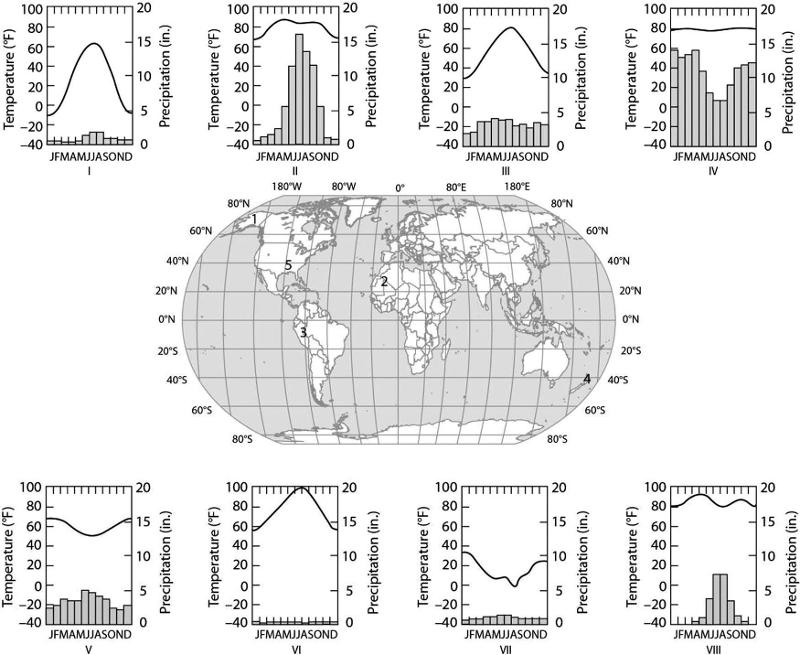
Which climograph shows the climate for location 1?
- A) I
- B) III
- C) V
- D) VII
- E) VIII
A
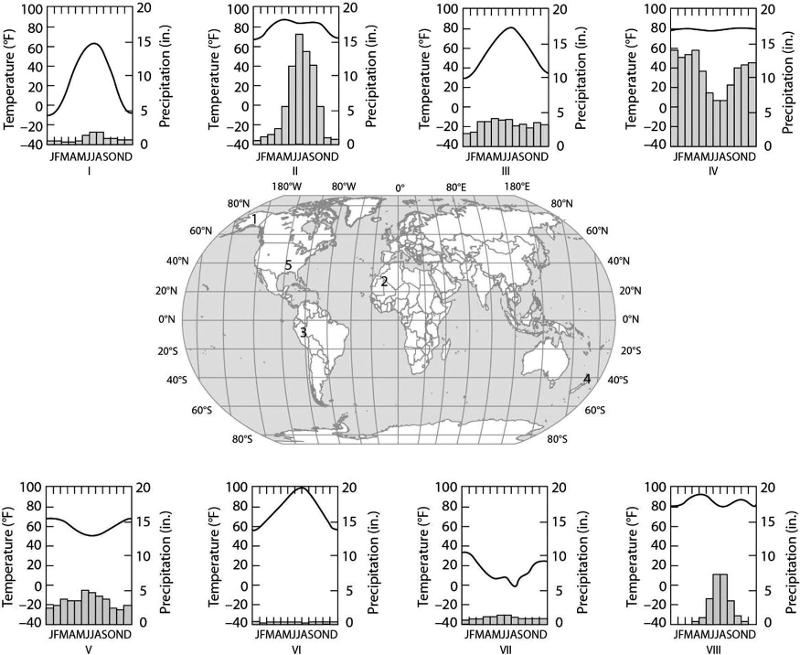
Which climograph shows the climate for location 2?
- A) II
- B) III
- C) IV
- D) VI
- E) VIII
D
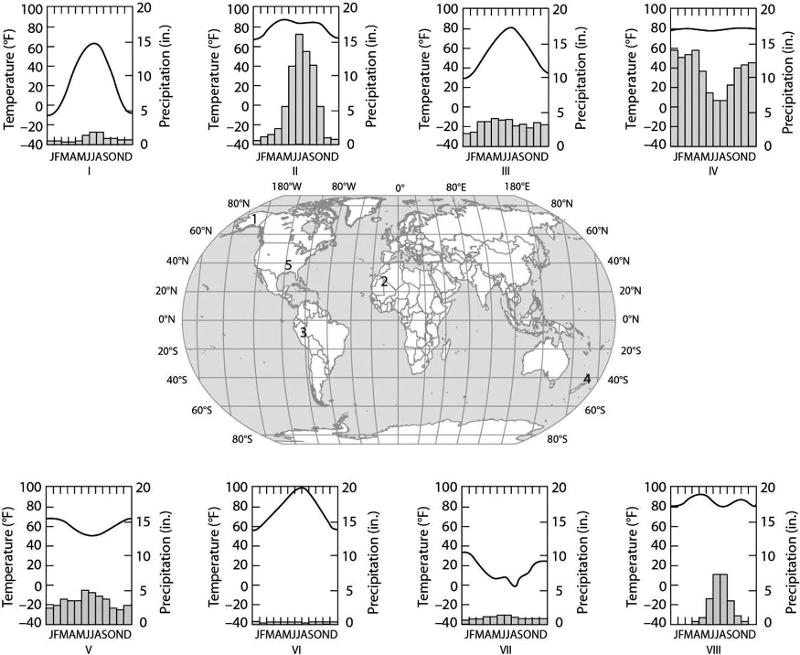
Which climograph shows the climate for location 3?
- A) II
- B) III
- C) IV
- D) V
- E) VI
C
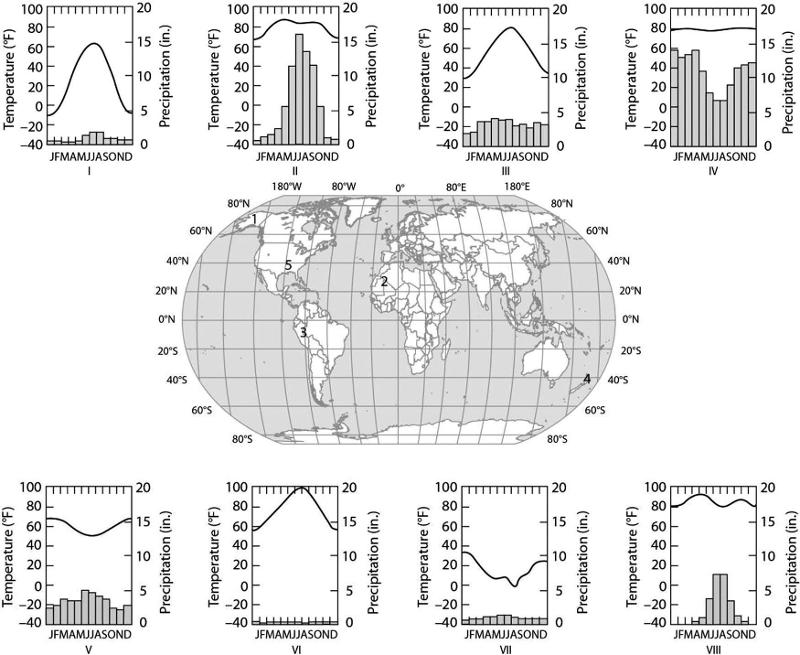
Which climograph shows the climate for location 4?
- A) I
- B) II
- C) III
- D) V
- E) VI
D
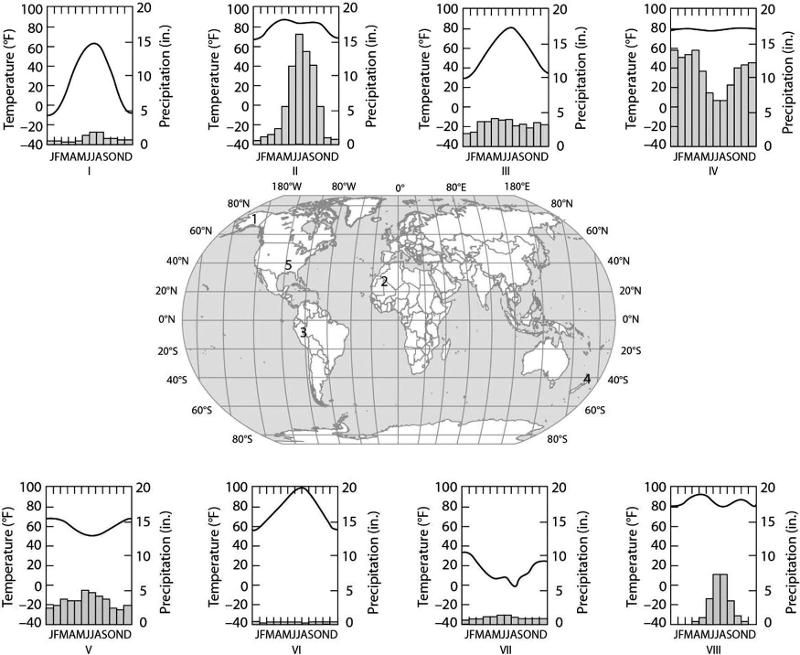
Which climograph shows the climate for location 5?
- A) I
- B) III
- C) IV
- D) V
- E) VIII
B
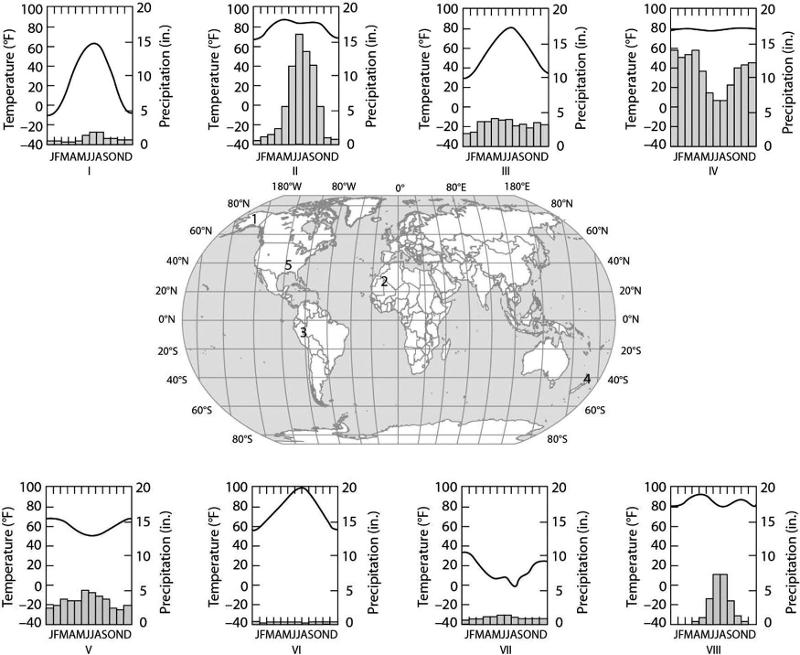
Which of the following best substantiates why location 3 is an equatorial (tropical) climate?
- A) It has a monsoon season during the winter months.
- B) It has consistent monthly averages for rainfall.
- C) The temperature is high for each monthly average.
- D) The temperatures reach 100°F during some months.
- E) The temperatures are lower in June, July, and August.
C
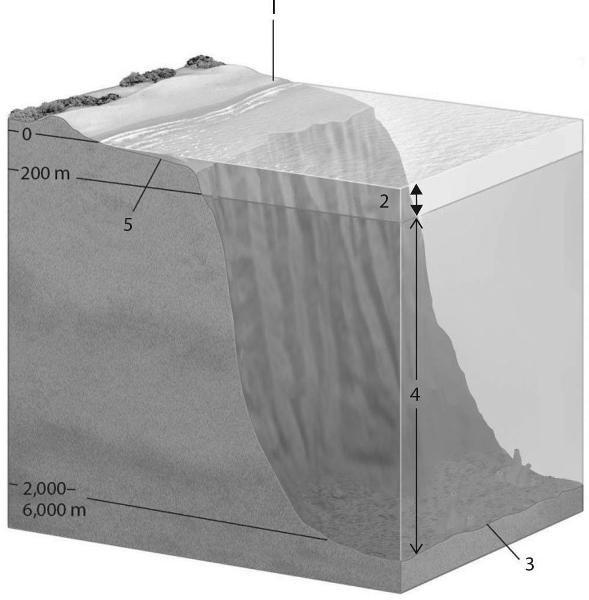
Which zone has a condition of constant temperature?
- A) 1
- B) 2
- C) 3
- D) 4
- E) 5
C
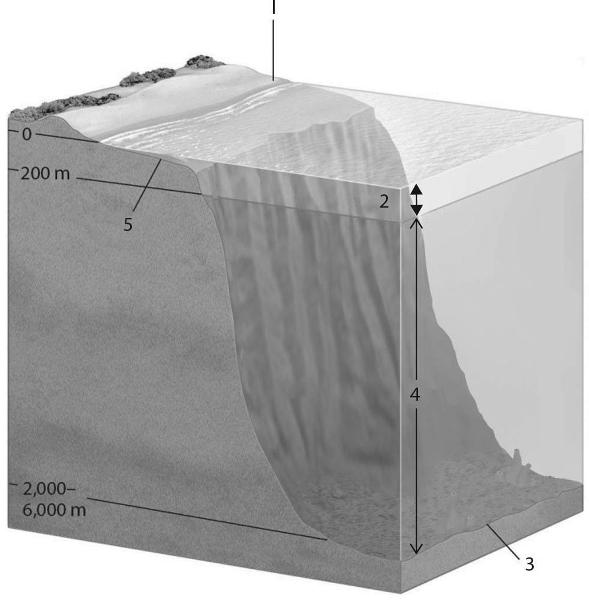
Which zone produces the most global oxygen?
- A) 1
- B) 2
- C) 3
- D) 4
- E) 5
B
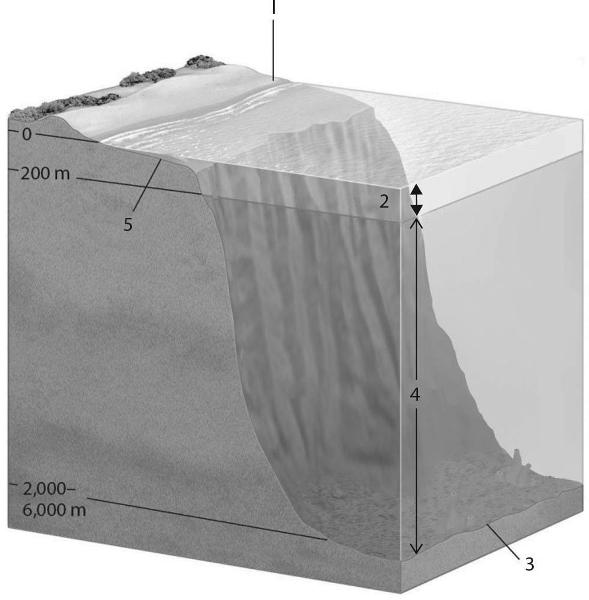
Which zone has the lowest biomass per unit of volume?
- A) 1
- B) 2
- C) 3
- D) 4
- E) 5
D
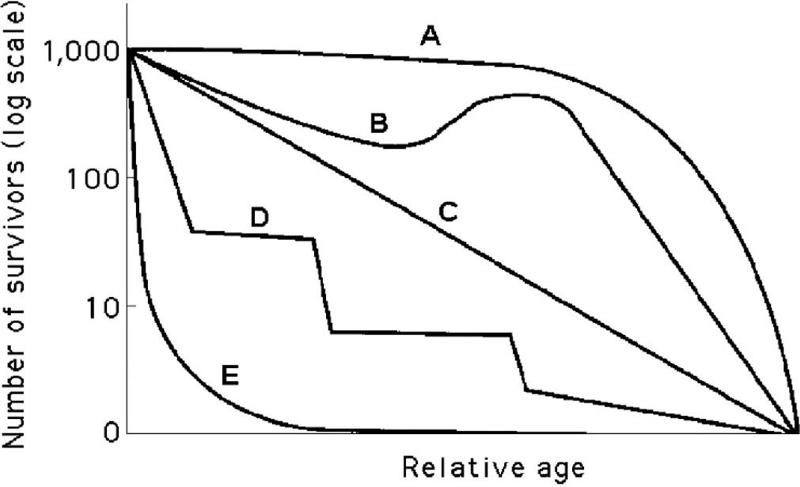
Which statement best explains survivorship curve B?
- A) It is likely a species that provides little postnatal care, but lots of care for offspring during midlife, as indicated by increased survivorship.
- B) This curve is likely of a species that produces lots of offspring, only a few of which are expected to survive.
- C) It is likely a species where no individuals in the cohort die when they are at 60-70% relative age.
- D) There was a mass emigration of young to middle-aged individuals in this cohort.
- E) Survivorship can only decrease; therefore, this curve could not happen in nature.
E
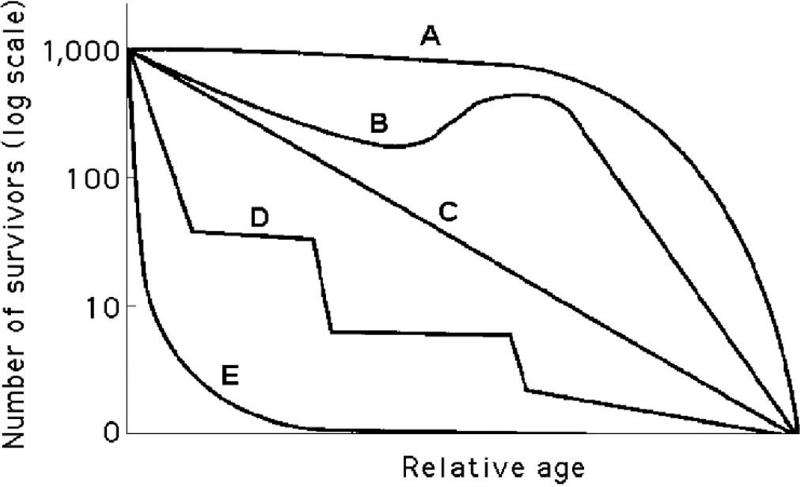
In Figure 40.3, which curve best describes survivorship in marine molluscs?
- A) A
- B) B
- C) C
- D) D
- E) E
E
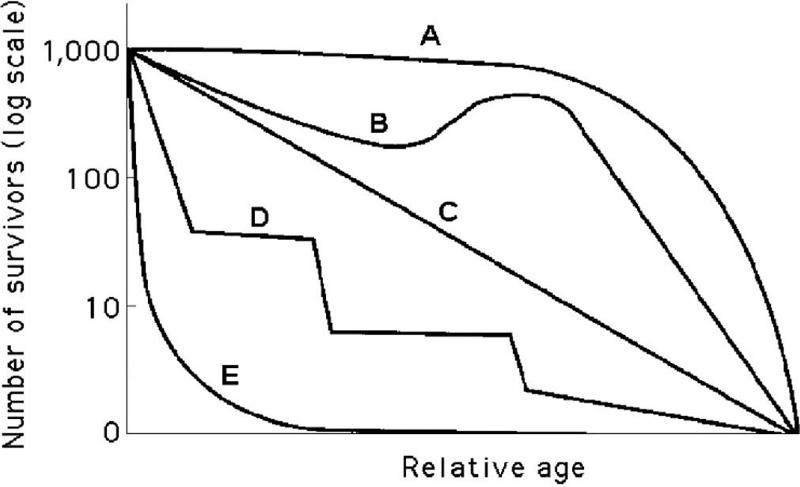
Which curve best describes survivorship in elephants?
- A) A
- B) B
- C) C
- D) D
- E) E
A
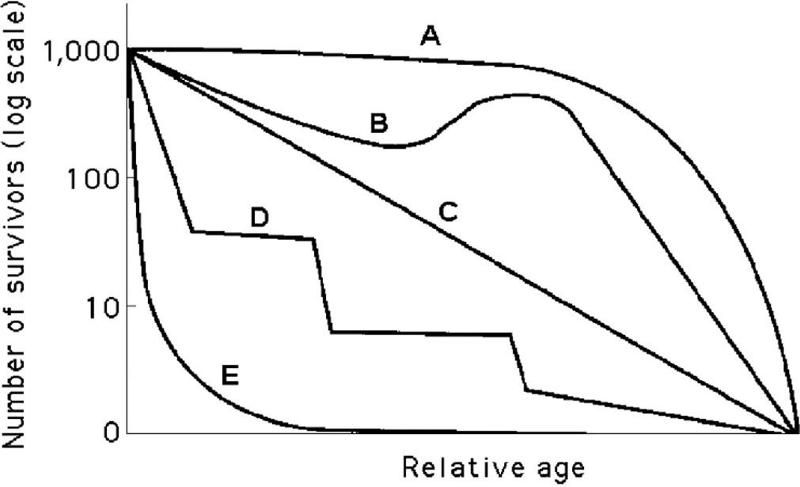
Which curve best describes survivorship in a marine crustacean that molts (i.e., sheds its exoskeleton in order to grow)?
- A) A
- B) B
- C) C
- D) D
- E) E
D
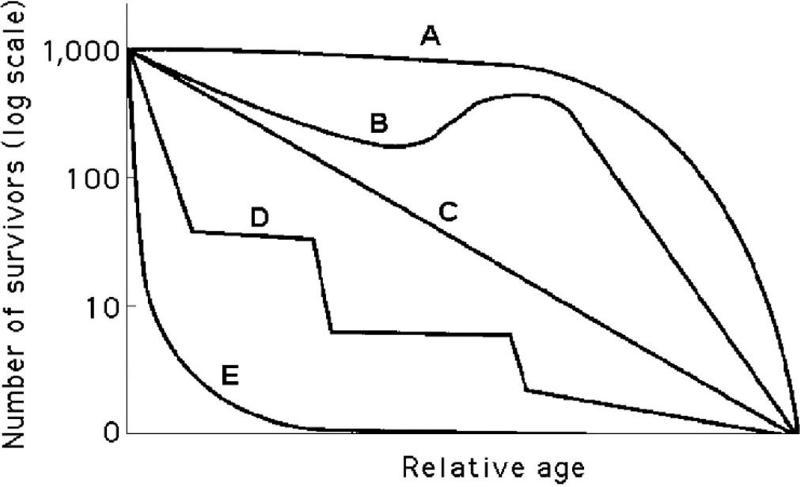
Which curve best describes survivorship in humans who live in developed nations?
- A) A
- B) B
- C) C
- D) D
- E) E
A
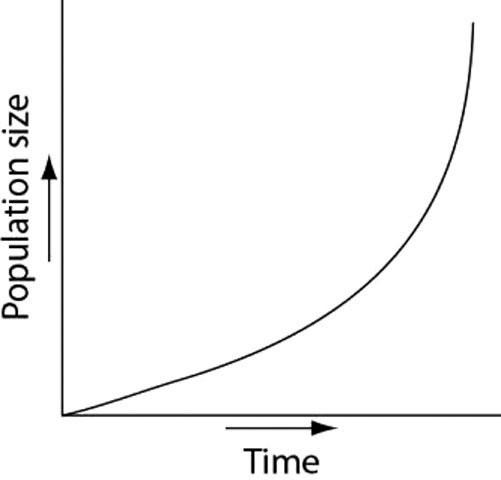
Which of the following graphs illustrates the population growth curve of single bacterium growing in a flask of ideal medium at optimum temperature over a 24-hour period?
see graph for awnser
A
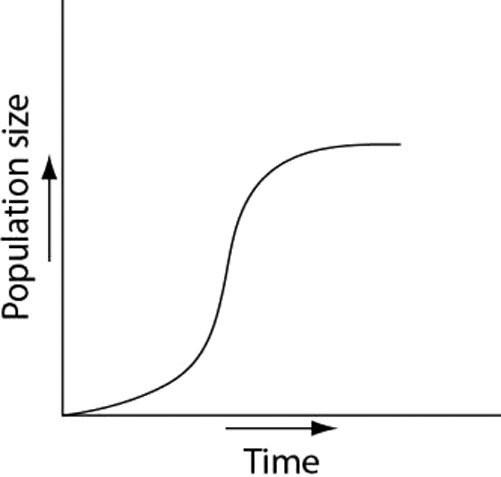
Which of the following graphs illustrates the growth curve of a small population of rodents that has grown to reach a static carrying capacity?
see graph for awnser
A
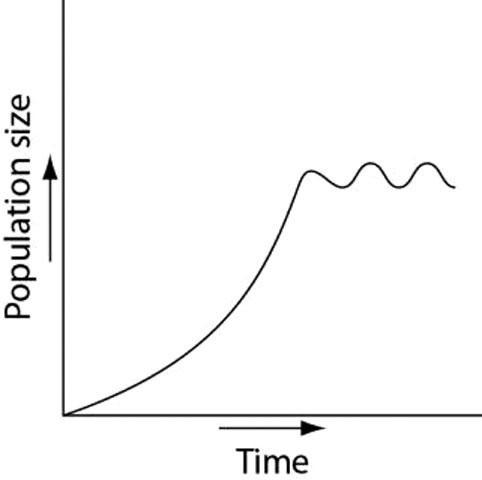
Which of the following graphs illustrates the growth over several seasons of a population of snowshoe hares that were introduced to an appropriate habitat also inhabited by predators in northern Canada?
see graph for awnser
A